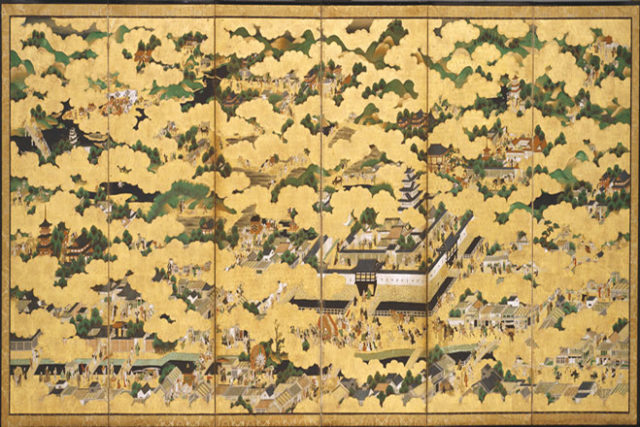
By Shihou Sasaki
The Seattle Art Museum’s historic Japanese art will undergo major conservation work to preserve it for its major collection. A pair of Japanese screens will be sent to California’s Studio Sogendo, a private conservation studio, for restoration, with the Bank of America Art Conservation Project sponsorship.
“Scenes in and around the Capital (75.38.1 & 2), a pair of six-panel Japanese screens from the Edo period (1603–1868), present a charming view of daily life in Kyoto using ink, color, and gold,” according to SAM. “The screens depict residents and visitors moving about the city—including the imperial castle—and into the countryside.”
The museum acquired the artworks in 1975 and has displayed them over the years at various exhibitions including “Tabaimo: Utsutsushi Utsushi” from November 2016 to February 2017, “Japan Envisions the West: 16th-19th Century Japanese Art from the Kobe City Museum” from October 2007 to January 2008 and “A Thousand Cranes: Treasures of Japanese Art” from February to July in 1987.
According to SAM, the screens were already in fragile condition in 1975, and it is “now crucial that structural conservation take place to preserve the screens and prevent future damage.”
“Conservation of this splendid painting has been a preservation priority for us for some time, but the significant expense and logistical challenges of projects like this, typically put them out of reach of our normal operating budget,” Nicholas Dorman, SAM’s Chief Conservator. “The Bank of America program is one of only very few initiatives that provide conservation project support for major treatment projects and we are indebted to them for choosing to partner with SAM once again as we preserve our collections for generations to come.”
Tomokatsu Kawazu, president and head conservator of Studio Sogendo, will conduct the project. The conservation work will take about two years after the SAM sends the screens to the studio in spring. Xiaojin Wu, SAM’s Curator of Japanese and Korean Art, said that she hopes to showcase the screens as soon as they return to the museum, but the details have not been planned yet.
“Across the Puget Sound, we support giving a voice to multicultural experiences and sharing stories that showcase how the arts contribute to our thriving economy—from local consumer spending and revenue generation for local businesses, to job creation and regional tourism. We’re honored to be working with SAM to help conserve Scenes in and around the Capital, so that it will continue to inspire and educate future generations,” said Anthony DiBlasi, Seattle market and Washington state president, Bank of America.
Scenes in and around the Capital has been one of the SAM’s over 3,400 Japanese art and artifacts collections. “It is an example of the type of artistic treasures that will be further protected following the completed renovation of the Asian Art Museum, currently underway,” according to the SAM.



